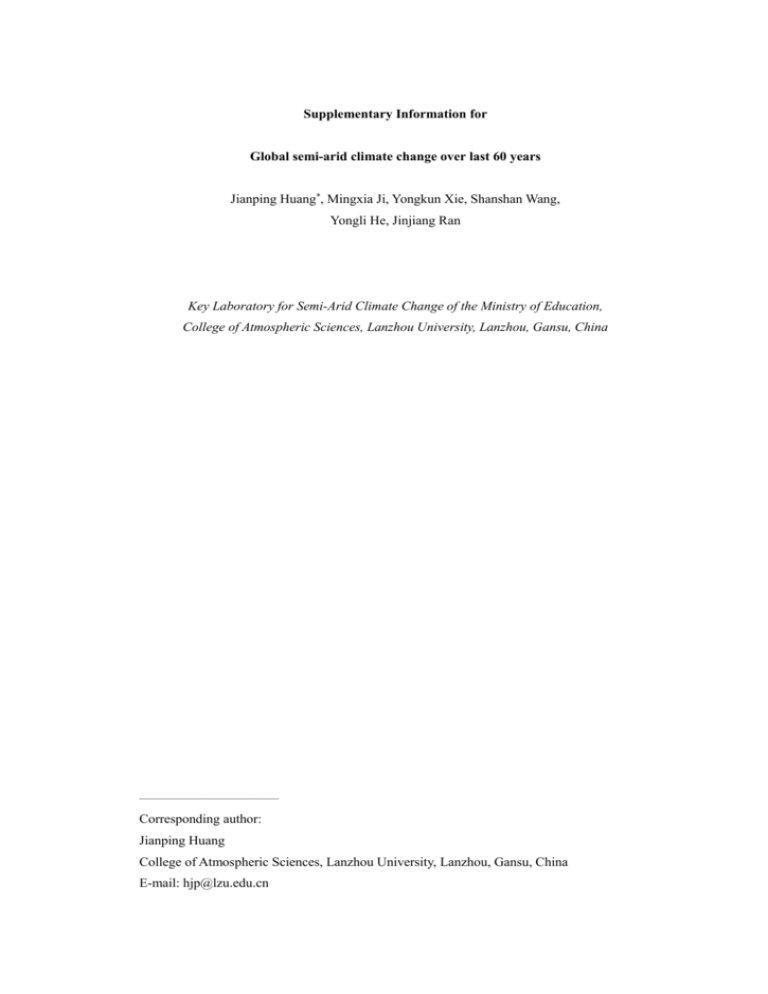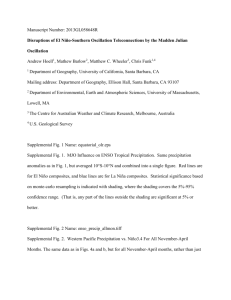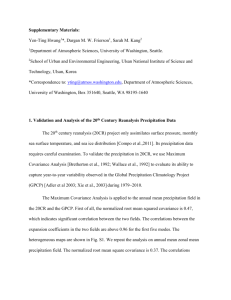Supplementary Information for Global semi
advertisement

Supplementary Information for Global semi-arid climate change over last 60 years Jianping Huang*, Mingxia Ji, Yongkun Xie, Shanshan Wang, Yongli He, Jinjiang Ran Key Laboratory for Semi-Arid Climate Change of the Ministry of Education, College of Atmospheric Sciences, Lanzhou University, Lanzhou, Gansu, China _______________________________ Corresponding author: Jianping Huang College of Atmospheric Sciences, Lanzhou University, Lanzhou, Gansu, China E-mail: hjp@lzu.edu.cn 1. Long-term trend of wind speed Fig. S1 show the distribution of the linear trends of the terrestrial wind speed by using the GLDAS data. The wind speed decreases during the last 61 years in Northern Hemisphere, such as East Asia, Central Asia, and northern Africa regions, while increasing trends are apparent in part of South America and other small areas. Fig. S2 shows the regionally averaged wind speed from GLDAS in global land surface, Northern Hemisphere and mid-latitude regions in Northern Hemisphere respectively. Fig. S1 The distribution of the linear trends of the terrestrial wind speed from GLDAS for 1948-2008. Fig. S2 The variations of the regionally averaged wind speed over global land surface (black curve), Northern Hemisphere (blue curve), and mid-latitude regions in Northern Hemisphere (red curve) from 1948 to 2008. 2. Comparison of precipitation trends in semi-arid regions Fig. S3 shows the distributions of the linear trends of precipitation in semi-arid regions by using CRU (Harris et al. 2014), GPCC (Schneider et al. 2011), and UDel (Legates and Willmott 1990) datasets. It can be found that both datasets have a good agreement with each other. In addition, the variations of the regional averaged trends of precipitation in typical semiarid regions are shown in Fig. S4-S6, and there are only small difference of the precipitation trends between three datasets. Fig. S3 The distributions of the linear trends in the precipitation in semi-arid regions globally by using CRU, GPCC, and UDel datasets from 1948 to 2008. Fig. S4 The variations of the regionally averaged precipitation in the semi-arid regions over East Asia, Central Asia, and North America by using CRU (left column), GPCC (middle column), and UDel (right column) datasets from 1948 to 2008. The blue curve indicates the newly formed semi-arid regions, and the black curve denotes the old semi-arid regions. Fig. S5 Same as Fig. S4 but for southern Africa, central/west Australia, and east Australia semi-arid regions. Fig. S6 Same as Fig. S4 but for northern Africa semi-arid regions. References Harris I, Jones P, Osborn T, Lister D (2014) Updated high-resolution grids of monthly climatic observations-the CRU TS3. 10 Dataset. Int J Climatol 34(3): 623-642 Legates DR, Willmott CJ (1990) Mean seasonal and spatial variability in gauge-corrected, global precipitation. Int J Climatol 10(2): 111-127 Schneider U, Becker A, Finger P, Meyer-Christoffer A, Rudolf B, Ziese M (2011) GPCC Full Data Reanalysis Version 6.0 at 0.5o: Monthly Land-Surface Precipitation from Rain-Gauges built on GTS-based and Historic Data. DOI: 10.5676/DWD_GPCC/FD_M_V6_050







